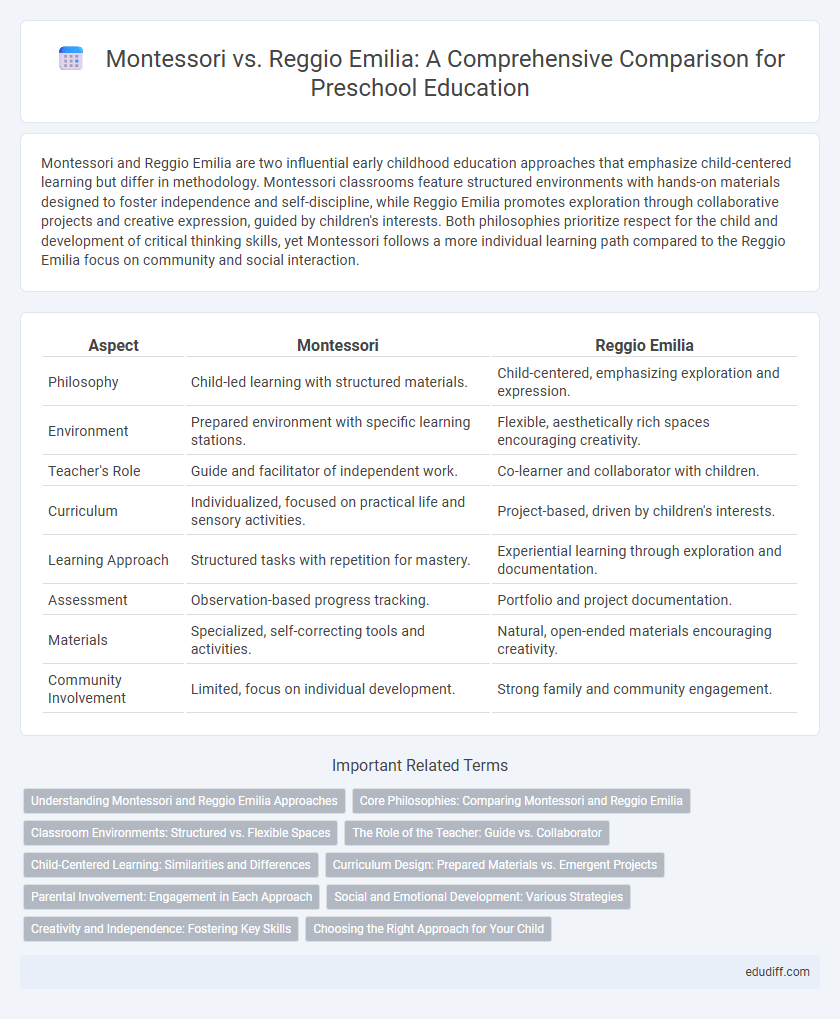Montessori and Reggio Emilia are two influential early childhood education approaches that emphasize child-centered learning but differ in methodology. Montessori classrooms feature structured environments with hands-on materials designed to foster independence and self-discipline, while Reggio Emilia promotes exploration through collaborative projects and creative expression, guided by children's interests. Both philosophies prioritize respect for the child and development of critical thinking skills, yet Montessori follows a more individual learning path compared to the Reggio Emilia focus on community and social interaction.
Table of Comparison
| Aspect | Montessori | Reggio Emilia |
|---|---|---|
| Philosophy | Child-led learning with structured materials. | Child-centered, emphasizing exploration and expression. |
| Environment | Prepared environment with specific learning stations. | Flexible, aesthetically rich spaces encouraging creativity. |
| Teacher's Role | Guide and facilitator of independent work. | Co-learner and collaborator with children. |
| Curriculum | Individualized, focused on practical life and sensory activities. | Project-based, driven by children's interests. |
| Learning Approach | Structured tasks with repetition for mastery. | Experiential learning through exploration and documentation. |
| Assessment | Observation-based progress tracking. | Portfolio and project documentation. |
| Materials | Specialized, self-correcting tools and activities. | Natural, open-ended materials encouraging creativity. |
| Community Involvement | Limited, focus on individual development. | Strong family and community engagement. |
Understanding Montessori and Reggio Emilia Approaches
Montessori and Reggio Emilia approaches both emphasize child-centered learning but differ in methodology and environment; Montessori prioritizes structured, individualized activities using specialized materials to foster independence, while Reggio Emilia focuses on collaborative projects and expressive arts, highlighting community and communication. The Montessori method relies on a prepared environment that encourages self-directed exploration, promoting cognitive and practical life skills through repetition and order. Conversely, Reggio Emilia values documentation and interaction, viewing the child as a protagonist in their learning journey supported by teachers and parents within a rich, aesthetically stimulating setting.
Core Philosophies: Comparing Montessori and Reggio Emilia
Montessori education emphasizes self-directed learning, individual pacing, and hands-on materials designed to develop practical skills and sensory awareness, promoting independence and structured freedom. Reggio Emilia centers on child-led exploration, collaborative group work, and expressive arts, fostering creativity, communication, and social interaction within a community environment. Both approaches value respect for the child but differ in structure, with Montessori providing a prepared environment and specific materials, while Reggio Emilia relies on the environment as a "third teacher" encouraging emergent curriculum based on children's interests.
Classroom Environments: Structured vs. Flexible Spaces
Montessori classrooms feature structured environments with defined learning stations and orderly materials designed to promote independence and focused skills development. Reggio Emilia spaces emphasize flexible, open areas that encourage creativity and collaboration, with natural light and diverse materials fostering spontaneous exploration. Both approaches optimize classroom design to support differentiated learning styles and developmental needs in early childhood education.
The Role of the Teacher: Guide vs. Collaborator
In Montessori preschools, the teacher serves primarily as a guide who carefully prepares the environment and directs children's independent learning through structured materials. In contrast, Reggio Emilia educators act as collaborators, engaging in ongoing dialogue and co-constructing knowledge with children based on their interests and experiences. This fundamental difference shapes the classroom dynamics, with Montessori emphasizing self-directed learning and Reggio Emilia fostering interactive exploration and social collaboration.
Child-Centered Learning: Similarities and Differences
Montessori and Reggio Emilia both emphasize child-centered learning by fostering independence and encouraging exploration, yet Montessori uses structured, self-directed activities with specific materials, while Reggio Emilia prioritizes collaborative projects and expressive arts. Reggio Emilia highlights the environment as the "third teacher," promoting social interaction and creativity, whereas Montessori environments are carefully prepared to support individual work and sensory development. Both approaches respect the child's interests and pace but differ in their pedagogical methods and classroom dynamics.
Curriculum Design: Prepared Materials vs. Emergent Projects
Montessori curriculum design emphasizes prepared materials that follow a structured progression to develop specific skills and foster independence in preschool children. Reggio Emilia curriculum centers around emergent projects, where learning is driven by children's interests and collaborative exploration, promoting creativity and critical thinking. Both approaches prioritize child-centered learning but differ significantly in material preparation and instructional flexibility.
Parental Involvement: Engagement in Each Approach
Montessori emphasizes structured parental involvement through regular communication, workshops, and home activities that reinforce independence and self-discipline. Reggio Emilia actively integrates parents as co-collaborators in the learning process, encouraging participation in classroom projects and documentation. Both approaches recognize the critical role of parental engagement, but Reggio Emilia fosters a more collaborative and continuous partnership between educators and families.
Social and Emotional Development: Various Strategies
Montessori emphasizes individual work cycles and self-regulation to foster independence and emotional resilience in preschoolers, using structured environments and hands-on materials. Reggio Emilia prioritizes collaborative group projects and expressive arts to promote social interaction and emotional communication through community involvement. Both approaches utilize observation and reflection but differ in balancing autonomy with social engagement for holistic emotional growth.
Creativity and Independence: Fostering Key Skills
Montessori classrooms emphasize hands-on learning with structured materials that promote independence and self-discipline, while Reggio Emilia nurtures creativity through collaborative projects and expressive arts. Both approaches encourage decision-making and problem-solving, essential for cognitive growth in early childhood. By integrating sensory experiences and social interaction, these methods support the development of critical skills that prepare preschoolers for lifelong learning.
Choosing the Right Approach for Your Child
Montessori emphasizes individualized learning through hands-on activities and structured environments, fostering independence and self-discipline in preschool children. Reggio Emilia prioritizes collaborative projects, creativity, and emergent curriculum, encouraging communication and social development. Choosing the right approach depends on your child's learning style, social needs, and your family's educational values.
Montessori vs Reggio Emilia Infographic

 edudiff.com
edudiff.com